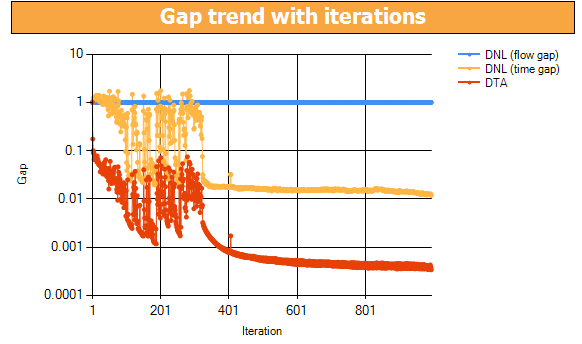The DTA fixed-point problem (equilibrium) can be associated to three gap functions:
- DTA gap
- DNL gap (time)
- DNL gap (flow)
The gap functions are indicators of reaching the convergence of the DTA equilibrium, and they are expected to be null at that point.
The DTA gap (see → Running day type simulations using DTA mode) function provides an indicator of how far the (destination) route choices are from the minimum ones (for example, in case no one is expected to change their route choice).
The DNL gap functions (see → Running day type simulations using DNL mode) provide other indicators of the DTA problem, based on reaching convergence of diversion route choices and link propagation travel times, under the assumption of flow conservation at the diversions.
DNL gap on times has a trend similar to the DTA one, because of the correlation between link travel times and costs
DNL gap on flows instead typically shows bigger fluctuations, as route choice changes produce bigger modifications in the subsequent volumes.

For example, in the figure is evident a first transitory time with very different values; after a specific point (in this case, around 350 iterations), you get a smooth curve.
Typically the transitory is related to the strong congestion in the network.
A possible remedy could be:
- A former assignment deactivating spillback, with a second assignment loading initial solution.
- If you want to run a huge number of iterations (for example, 1000), you can set a big number of warmup iterations (for example, 900 iterations starting with 20% WarmStartShare) and then let the algorithm balance that obtained situation (in up to 100 iterations).

| Parameter | Description |
|---|---|
|
T |
Set of turns. |
|
I |
Set of DTA intervals. |
|
cdt,i |
Cost to reach destination d, from the head node of the backward link of turn t at the final instant of DTA interval i. |
|
tail(t) |
Backward link of turn t. |
|
FSa |
Turn forward star of link a. |
|
volt,i |
Volume of turn t during DTA interval i. |

| Parameter | Description |
|---|---|
|
A |
Set of links. |
|
I |
Set of DTA intervals. |
|
ttitea,i |
Link travel time entering link a at the final instant of DTA interval i during iteration ite. |
|
vola,i |
Volume of link a during DTA interval i. |

| Parameter | Description |
|---|---|
|
A |
Set of links. |
|
I |
Set of DTA intervals. |
|
ttitea,i |
Link travel time entering link a at the final instant of DTA interval i during iteration ite. |
|
vola,i |
Volume of link a during DTA interval i. |